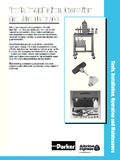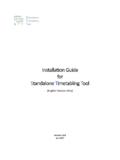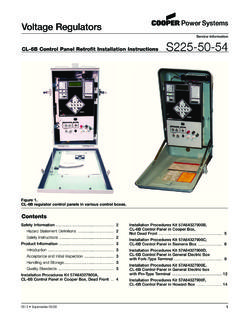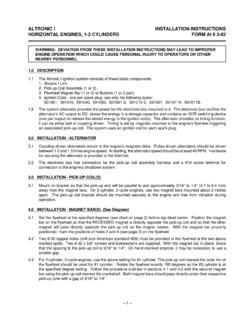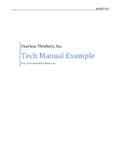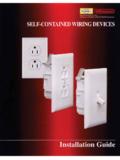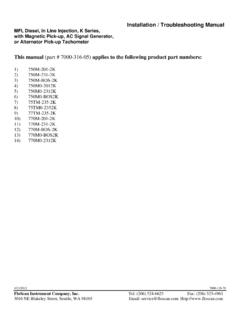Transcription of REFERENCE STANDARD RS-19 - City of New York
1 REFERENCE STANDARD 19 REFERENCE STANDARD RS-19 SAFETY OF PUBLIC AND PROPERTY DURING CONSTRUCTION OPERATIONS * LIST OF REFERENCED NATIONAL standards ANSI Power Actuated Fastening Systems- Safety Requirements, as ANSI American national STANDARD for personnel and debris nets used during construction, repair and demolition operations, as modified..1989 **ANSI Mobile and Locomotive Cranes - Chapter 5-1 except Section ..2000 **ANSI Mobile and Locomotive Cranes - Chapter 5-1 except Section ..1994 **ANSI Mobile and Locomotive Cranes - Chapter 5-1 except Section ..1989 **ANSI Mobile and Locomotive Cranes - Chapter 5-1 except Section ..1982 **ANSI Mobile and Locomotive Cranes - Chapter 5-1 except Section.
2 2004 **ANSI Mobile and Locomotive Cranes ..1968 **CEN EN 13000 Cranes Mobile Cranes, except Section ..2004 *Local Law 61-1987; 111-90 BCR; 234-90 BCR; 1155-80 BCR **DOB 10/1/06 ** REFERENCE STANDARD RS 19-1 ANSI 1985-Power-Actuated Fastening Systems-Safety Requirements, as Modified. provisions of ANSI shall be subject to the following modifications. The section numbers are from that STANDARD . Amend section to read as follows: Medium-velocity tools, indirect-acting (piston) type, as defined in section 3, shall (meet the requirements of ) not be accepted. Delete sections , and Amend section to read as follows: High velocity tools, direct-acting or indirect-acting type, as defined in section 3, shall (meet the requirements of ) not be accepted.
3 Delete sections , and As enacted, but probably intended Add the following new section: Selection of employer shall knowingly furnish to an employee for use in a tool any cartridge or load not suitable for safe use in that tool, whether by reason of excessive power, improper design or poor material. The operator shall use due care to select the proper cartridges or power loads, or other means of controlling the force of the explosion so that is develops no more than the necessary pressure to bring about the desired penetration. In doing so, the operator shall be guided by the manufacturer s specifications. Proper doubt exists (as to proper load), the operator shall make a trial shot to test the surface and the strength of the material to be penetrated.
4 The trial shot shall be made with the lowest power level and then increasing strength until a proper fastening is made. During this test, the operator and all bystanders shall adhere to all safety rules including, but not limited to wearing goggles and hard hats required for the job. Add the following sentence before the first sentence in section : The operator shall always verify the thickness and type of material into which the stud, pin or fastener is to be driven. Add the following sections: Storage of power loads shall be in accordance with the requirements of Fire Prevention Directive 2-62 R, dated February 21, 1979, Division of Fire Prevention, entitled "Regulations Governing the Use and Storage of Ammunition for the Construction and Alteration of Buildings.
5 " The authorized instructors' card shall list the specific model(s) of powder actuated tool(s) for which training may be given. All authorized instructors shall hold a Certificate of Fitness issued by the Fire Department. The qualified operator s card shall list the specific model(s) of powder actuated tool(s) which may be used. All qualified operators shall hold a Certificate of Fitness issued by the Fire Department. 12. Materials and Equipment Acceptance Division. Powder-actuated tools using ammunition (power loads) accepted by the Materials and Equipment Acceptance Division and shall be accompanied by such a label. MEA acceptance label may be attached to the tool box or to the operator s manual in lieu of attaching it to the tool but, in any event must be kept available for inspection.
6 13. Fire Department Requirements. The requirements of Fire Department, Division of Fire Prevention, Directive 2-62 R, dated February 21, 1979, entitled "Amended Regulations Governing the Use and Storage of Ammunition for the Construction and Alterations of Buildings" shall be complied with. The following is extracted from such regulations: a. Powder actuated tools utilizing ammunition (power loads) shall be used only by a person holding a revision: July 1, 2008 379 REFERENCE STANDARD 19 Certificate of Fitness issued by the Fire Department upon a submission of evidence that person has satisfactorily completed a training program in the safe use of such equipment, acceptable to the Fire Department.
7 B. No powder actuated tool utilizing ammunition (power loads) shall be used unless the Certificate of Fitness holder establishes a safe zone behind the work area by the use of a one-quarter inch steel back-up plate and/or maintenance of an area clear of all people. **111-90 BCR **RS 19-2 POWER OPERATED CRANES AND DERRICKS STANDARD applies to the construction, installation, inspection, maintenance and use of power operated cranes and derricks used for hoisting and/or rigging purposes; or used for the construction, alteration, demolition, excavation and maintenance purposes, including highways or sewers; or used for the installation of piles; or used for the hoisting or lowering of any article on the outside of any building or structure.
8 From the requirements of this REFERENCE STANDARD are the following: Cranes or derricks used in industrial or commercial plants or yards and floating cranes, floating derricks and cranes and derricks used on floating equipment. Also augers, churn-drills and other drilling equipment. Operators of such equipment shall be exempt from any licensing requirements. Operators of cranes described in section (a)(3) and (4) of the administrative code shall be exempt from any licensing requirements where the cranes are used in connection with the installation or maintenance of street lighting or public utility overhead power distribution systems.
9 Derricks having a maximum rated capacity not exceeding one ton. secondary part of assembly of parts which contributes to the overall function and usefulness of a machine. specific responsibilities by the employer or by the employers representative. ANGLE INDICATOR (boom).-An accessory which measures the angle of the boom to the horizontal. AUXILIARY (See Whipline). AXIS OF vertical axis around which the crane superstructure rotates. shaft or spindle with which or about which a wheel rotates. On truck and wheel mounted cranes it refers to an automotive type of axle assembly including housing, gearing, differential, bearings and mounting appurtenances.
10 AXLE (bogie).-Two or more automotive type axles mounted in tandem in a frame so as to divide the load between the axles and permit vertical oscillation of the wheels. BASE (mounting).The base or carrier on which the rotating superstructure is mounted such as a truck, crawler or platform. BOOM. A timber or metal section or strut. The heel (lower end) is affixed to a base, carriage or support, and the upper end supports a cable and sheaves where the load is lifted by means of wire rope and hook. BOOM ANGLE. The angle between the longitudinal centerline of the boom and the horizontal. The boom longitudinal centerline is a straight line between the boom foot pin (heel pin) centerline, and boom point sheave pin centerline.












